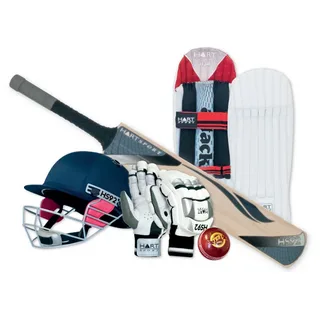Cricket Equipment Essentials: The Complete Player’s Guide for 2025

Cricket is more than just a sport—it's a tradition, a passion, and for many, a way of life. While skills and strategy are fundamental, the role of well-chosen cricket equipment cannot be overstated. Whether you're a beginner, intermediate, or advanced player, having the right gear is essential for improving performance, ensuring safety, and enhancing your overall experience on the field.
This comprehensive guide covers all categories of cricket equipment used in modern formats of the game, from bats and balls to protective gear and training accessories. Designed for players, coaches, and even parents of young cricketers, this article will help you make informed decisions about your gear in 2025 and beyond.
1. Cricket Bats: Power and Precision in Every Stroke
The cricket bat is the centerpiece of a batter's gear. Designed to balance power and control, bats are available in various weights, shapes, and materials.
Bat Material
-
English Willow: Lightweight, responsive, and typically used by professional players. Known for superior grain quality and stroke feel.
-
Kashmir Willow: Heavier but more durable, preferred by casual or entry-level players. Offers good value for training and amateur matches.
Sizes and Shapes
-
Cricket bats come in sizes ranging from size 0 (for very young children) to full-size (SH - Short Handle and LH - Long Handle).
-
Modern bats have thicker edges, curved spines, and concave scoops to enhance sweet spots.
Knocking-In and Maintenance
-
Bats require knocking-in to prepare the wood for ball impact.
-
Regular oiling and protective sheets help prolong a bat’s lifespan.
2. Cricket Balls: Engineered for Accuracy and Swing
The cricket ball is an essential component of every game format, determining much of the pace and style of play.
Ball Types
-
Red Balls: Used in Test matches and multi-day formats.
-
White Balls: Used in ODIs and T20s for high-visibility under floodlights.
-
Pink Balls: Designed for day-night matches due to their visibility.
Construction
-
Core: Made from cork or rubber, wound tightly with yarn.
-
Cover: High-quality leather stitched with a prominent seam for swing and spin.
Balls are available in different weights for juniors and seniors. Quality of the leather and finish impacts swing, seam movement, and durability.
3. Protective Gear: Safety Without Compromise
Modern cricket involves high-speed deliveries, making protective gear essential for players’ safety—especially batters and wicketkeepers.
Batting Pads
-
Protect the legs from shin to ankle.
-
Comprise foam, cane, and protective outer layers.
-
Adjustable straps provide a snug fit.
Gloves
-
Protect hands and fingers from fast bowlers.
-
Batting gloves are cushioned with finger protection and mesh panels for ventilation.
Helmets
-
Feature a hard outer shell with an inner foam layer.
-
Grills shield the face, and optional neck protectors enhance safety.
Additional Gear
-
Thigh Guards, Arm Guards, Chest Guards: For players facing fast bowlers.
-
Abdominal Guard (Box): Crucial for male cricketers to prevent injury from impact.
4. Wicketkeeping Equipment: Precision and Protection
Wicketkeepers play a demanding role requiring specialized equipment for both safety and agility.
Wicketkeeping Gloves
-
Larger than batting gloves.
-
Webbed between the fingers to aid catching.
-
Cushioned palms to absorb high-speed impact.
Inner Gloves
-
Worn beneath the main gloves.
-
Offer better grip and sweat absorption.
Wicketkeeping Pads
-
More compact and lighter than batting pads.
-
Allow for rapid lateral movement.
5. Cricket Shoes: Built for Speed and Stability
Cricket-specific footwear ensures traction, support, and comfort on various playing surfaces.
Types of Shoes
-
Spiked Shoes: Ideal for turf grounds. Provide grip while running or turning.
-
Rubber Sole Shoes: Best for hard or synthetic surfaces. Lightweight and versatile.
Key Features
-
Cushioned midsoles for shock absorption.
-
Reinforced toe areas for protection.
-
Ankle support for bowlers and all-rounders.
Shoes must be chosen based on your playing role and pitch surface to avoid fatigue and injury.
6. Clothing and Uniform: Function Meets Tradition
Cricket clothing has evolved to meet the needs of performance and comfort while retaining its traditional roots.
Match Kits
-
Light-colored kits (usually white) for red-ball cricket.
-
Colored kits for limited-overs formats (T20, ODI).
Training Apparel
-
Lightweight and moisture-wicking.
-
Includes shorts, tracksuits, and sweatshirts.
Caps and Hats
-
Provide sun protection for fielders.
-
Sweatbands and neck guards offer added comfort in warm climates.
7. Junior Cricket Equipment: Scaled for Young Cricketers
Children and teenagers require cricket gear tailored to their size, strength, and developmental stage.
Junior Bats and Balls
-
Lighter bats promote better technique without strain.
-
Softer balls (rubber, tennis, or foam) are safer and easier to control.
Protective Gear for Kids
-
All equipment should be proportionate to a child’s size.
-
Comfort and safety are the top priorities when selecting helmets, pads, and gloves.
Training Sets
-
Plastic stumps, bats, and balls are often used in schools or backyard training.
8. Training and Coaching Equipment
Training gear is critical for improving individual skills and team coordination.
Popular Training Tools
-
Bowling Machines: Deliver balls at consistent pace and length for batting practice.
-
Rebound Nets: Improve reflexes and catching.
-
Target Stumps: Help bowlers with accuracy.
-
Slip Catching Cradles: Simulate deflections for fielding drills.
Other Accessories
-
Bat Grips and Grip Cones: Ensure control and comfort.
-
Mallets and Toe Guards: Prepare and protect new bats.
9. Fielding Equipment and Accessories
Fielding is as important as batting and bowling. Dedicated equipment supports athleticism and accuracy.
Catching Gloves and Mitts
-
Used by coaches for fielding drills.
-
Heavily padded to handle repeated high-impact catches.
Training Balls
-
Lighter or rubber-coated for throwdown practice.
-
Some are weighted to build arm strength.
10. Cricket Bags: Organizing Gear for Travel and Storage
A good cricket bag keeps all equipment organized, protected, and easy to transport.
Types of Bags
-
Duffle Bags: Backpack-style, easy to carry.
-
Wheelie Bags: Larger with handles and wheels.
-
Compartment Bags: Include dedicated space for shoes, bats, helmets, etc.
Bag Features
-
Ventilated shoe compartments.
-
Waterproof compartments for clothes and accessories.
-
Padded bat sleeves to avoid cracks or dents.
11. Indoor Cricket and Modified Equipment
Indoor cricket requires specialized gear due to limited space and different rules.
Modified Equipment
-
Lightweight plastic bats.
-
Softballs designed to reduce damage indoors.
-
Flat-soled shoes that won’t damage indoor flooring.
Indoor Nets and Barriers
-
Help in simulating match environments.
-
Encourage fast-paced reaction training.
12. Maintenance and Care for Cricket Equipment
Proper maintenance extends the life of your gear and ensures reliable performance.
Bat Care
-
Apply linseed oil and anti-scuff sheets.
-
Regularly inspect for cracks and handle loosening.
Pad and Glove Care
-
Air them out after every game.
-
Clean stains with a soft cloth and mild detergent.
Ball Care
-
Store in a dry place.
-
Avoid using damaged balls that may cause injury.
13. Buying Tips for 2025
Shopping for cricket equipment can be overwhelming. Consider the following:
-
Purpose: Match or practice use?
-
Surface: Turf, synthetic, or indoor?
-
Age and Size: Especially important for junior players.
-
Fit and Comfort: Test gear before purchase.
-
Material Quality: Higher quality offers better longevity.
Buy gear that matches your skill level and playing conditions without overspending. Regularly upgrade based on your improvement and needs.




